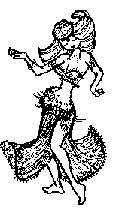|
Question: RE:
PROPS:
There's a new DVD
by Princess Farhana
which deals specifically with props, including candles and swords, balancing and
choosing props. You can buy it online in our catalogue. Farhana's Belly Dance
& Balance: The Art of Sword and Shamadan, 46 min Video-
"No other
video teaches these special aspects of balancing and also gives you the "nuts
and bolts" of preparation and care for your balance accessories. Additionally,
Princess Farhana reveals secrets about the hottest moves for enhancing your bellydance
performance. This video is a MUST for any dance video library." - Marta Schill,
co-author of The Compleat Belly Dancer and President of M.E.C.D.A. -- Thanks,
The Pink Gypsy
Hi there! I'm
looking for historical information on different belly dance props, particularly
for swords and canes. I'm also interested in more information on candles, flowers,
veils, zills, glasses, tamborines, and scarves. The
information I'm looking for is not how to use them, but along the lines of: Why
is a <prop name> used in a dance? Does it symbolize anything? Where/when
did it originate? What effect is trying to be achieved? I'm
often asked these questions after performing with a sword or cane, and it's awkward
when I can't give them historical background facts. Can you help? Or could you
recommend some books or other resources where I could do some digging myself?
Thanks so much! :-) - Juni (a.k.a. Tracey T.)]
Answer
1: Hello, Juni, ...
about dancing props. I can tell you what I know, and then refer you to some dancers'
websites that may be more beneficial to you. BTW, these are some excellent questions.
You ask particularly about cane and swords used
in our dance. I do know that cane dancing is an authentic dance type, commonly
known as Raks al Assaya. Raks being dance, assaya - cane. It is a feminine variation
of the Raks al Tahtib (stick dance) that men in Egypt perform. The
large sticks for the men represented weapons, so the dance is strong and forceful.
In direct opposition to this, women dance with delicate canes, with a lighthearted,
sassy emphasis. I do believe it is Saiidi in derivation, reflecting in the music
rhythm (called Saiidi), as well as the geographical location, the Saiidi port
in Egypt. Sword dancing is not derived
from any Arabic cultural dance, but has been brought into the "balancing" aspect,
that IS popular in the dance genre. That much being said, I will refer you to
two extremely knowledgeable dancers' home pages: Shira at www.shira.net , and
Morocco, at www.tiac.net/users/morocco Between these two sites, you will probably
glean as much info as you need, but if not, try to email them with your specific
questions. It is good to hear someone requesting
valid info on our dance form! Lots of misconceptions exist, and I think the truth
is just as fascinating as the fiction! I wish you the best. Catharae
Answer 2: "In regard to the use of props
in bellydance, you may want to contact someone in the S.C.A. or Society for Creative
Anachronism. They have dance & music guilds all over the country and guild
members are usually quite amazingly knowledgeable about things of this nature.
The S.C.A. website is www.sca.org"
April Hoy
Answer 3: "Oriental dance
is, reportedly, the most ancient recorded form of dance in the world. It was practiced
long before Arabs dominated the area we now know as the Middle East. However it
has become an integral and recognizable part of Arabic culture over time. Throughout
the world dance has commonly been used to tell history, stories, to teach the
younger generation or replicate day to day activities. The physical motion of
say grinding wheat or gathering water was/is refined and expressed with music
to illustrate the duties of food preparation. Other
subjects may include sex education, birth, seduction, seasonal changes, combat,
courting and so on. That being said we know that Arabic dance did not originate
out of the nightclub- it came out of the village. You
indicated specifically that you were interested in cane and sword use, there historical
and or symbolic status. Cane dance is a FOLK dance. By folk I mean a dance done
by "common, working" people. The cane/stick is an instrument of rural living,
used for traversing, herding and other day to day practices. Items such as this
work there way into a cultures expression in dance like the basket with grain
or laundry, the pot to carry water and so on. In
regards to the sword, I have never seen or read of an Arabic woman dancing with
a sword. Once I saw an Arabic woman dance with two small daggers, which could
have been a personal statement rather than a cultural tradition, and that is the
closet to sword dance in the Middle East that I have witnessed. I have seen men
In North Africa perform dances with swords in mock battles. Veil,
I think this is kind of a controversial topic among dancers. I have seen footage
from the 1940's to present day that show Arabic women (in the Middle East) using
veils in stage performances. However they enter with the veil dancing to a fast
rhythm, it's never wrapped on their bodies, and is discarded rather quickly. That
pattern still holds true for Arabic women who use a veil in their performance
today. Egypt, where most public dancing is done in four star hotels etc., is 90%
Muslim, Islam is the official religion of Egypt. Taking a veil off and dancing
with it may look like stripping and it's an offense to Muslims who believe that
women should cover their hair and or face. In the United States, without the same
religious restrictions, dancing with a veil is quite popular. Some have commented
that when Hollywood got interested in "belly dance" in the 40's and 50's the American
dancers did not know enough movements to fill a routine and used a veil to eat
up time thus it was an American invention and not authentic Arabic dance but who
knows what people did/do in their homes... I
do not consider finger cymbals a prop they are a percussion instrument. The use
of finger cymbals affixed to the thumbs and middle fingers of male and female
dancers' hands was recorded as early as 500 A.D. Algeria,
Bahrain, Comoros, Djibouti, Egypt, Greece, Iraq, Iran, Israel/Palestine, Jordan,
Kuwait, Lebanon, Libya, Morocco, Oman, Qatar, Saudi Arabia, Tunisia, Turkey, UAE
and Yeman. First find the origin of the "prop" then focus on researching that
country. I have seen Tunisian women use ceramic water pots in their performance-
to gather more information I might contact a cultural preservation center in Tunisia
or a department at a University specializing in North African studies. These may
seem like long shots for such detailed information but it will turn you on to
people who have studied the arts of that region... BEWARE
of material that was written during the 18th century. Recent books such as Serpent
of the Nile use material from authors of the 18th century when Europeans had a
fascination with anything Oriental. European MEN (and virtually only men) travelers
in Arabic countries had about as much access to Arabic women as an infidel can
have, which is to say they met and saw prostitutes. Images through portrait and
written word were mostly the European's fantasy tinged with racism and not a reality."
BRANDT,GALIA galia_brandt@nonhp-ex.cv.hp.com
Answer
4: CANDLE DANCING I will tell you what
I know about votive candle dancing: Serena
was known as the dancer with candles. Years ago I thought she picked up the dance
in the Greek night clubs she performed in. Yet, recently I asked Rip (her husband)
how Serena came to dance with candles. He told me that when they were young they
saw a Filipino dancer perform with candles in his hands and balance them on his
feet. Rip said to Serena "why don't you try that?" Hence, she became famous for
her beautiful candle dance where she would flutter them on her belly. Moreover,
I am a Greek folk dancer (and belly dancer) and know that candle dancing is native
to Metalini Greece (bordering on Asia Minor--Turkey). This dance is a traditional
folk dance performed with candles in ones hands to a Sirto rhythm. The name of
the dance means "fire" in Greek. Steps are simple consisting of a step-back crossing
step in a triplet pattern. Moreover, the
dancer will turn with this step. Candles are held and spiraled in a circular manner.
Also they are brought into the dancer's chest and out to the audience. Sometimes
the dancer twists the candles in a figure eight over the head and down to the
body (in the same way American belly dancers do!!). In
conclusion, the candle dance comes from a variety of regions including Greece.
If anyone knows more about this dance please write me at: wingeddancer123@hotmail.com.
My web site is: www.wingeddancer.com.
Zahraa | 
